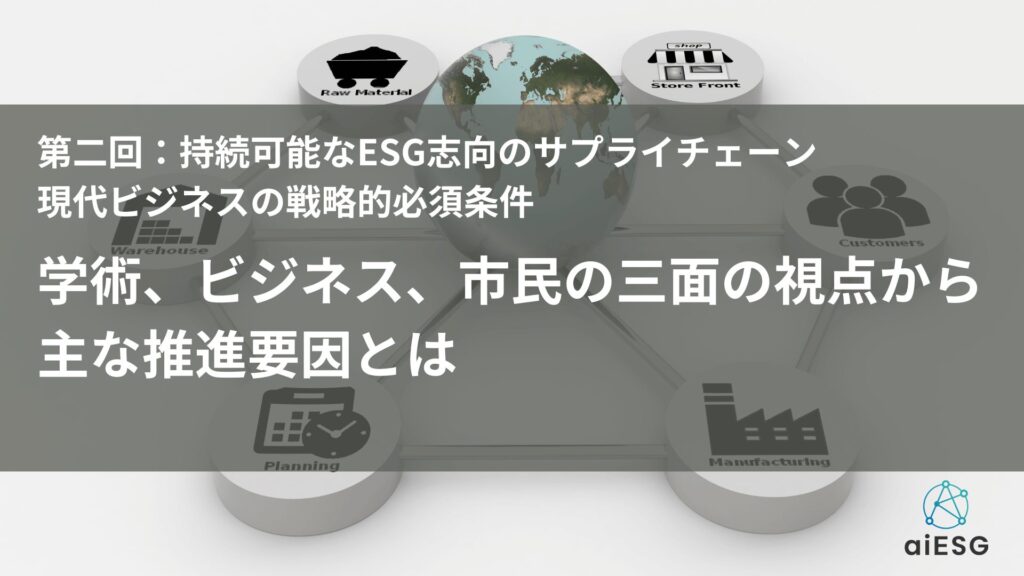INDEX
This is a Japanese translation of a manuscript written by aiESG's ESG research team and edited into three parts for publication. The English version of the manuscript isthis way (direction close to the speaker or towards the speaker)You can view it from
Please see the original article in English here.
Table of Contents:
Introduction.
Factors that drive companies to pursue supply chain sustainability
Benefits and opportunities of implementing an ESG-oriented supply chain
Risk of no action
Conclusion
Introduction.
This three-part series, "Sustainable ESG-Oriented Supply Chains: A Strategic Imperative for Modern Business," covers the relationship between supply chains and society and the environment, the impact that promoting sustainable supply chains can have on companies, and how to develop action plans to promote them.
In the first session, we introduced the importance of supply chain impacts on the environment and society, using examples from companies and the results of a United Nations study.
The Environmental and Social Impact of the Supply Chain
〜˜Sustainable ESG-oriented supply chains: a strategic imperative for modern business
In this second installment, we will examine the various factors behind the trend of companies implementing sustainability and ESG in their supply chains from three perspectives: academic, business, and citizen. It will also take a closer look at the benefits, opportunities, and risks of inaction that motivate companies to promote sustainability in their supply chains.
Factors driving corporate supply chain sustainability (3 perspectives)
A. From an Academic Perspective
<According to academic research, there are more than 40 reasons why companies are moving toward a sustainable supply chain.
A review of the academic literature related to sustainable supply chainsMore than 40 factors (also known as pressures, triggers, enablers, and drivers) have been identified that drive supply chain sustainability for organizations. The most frequently cited external pressures are government legislation, international regulations, and customer pressure. On the other hand, internal pressures related to corporate strategy (e.g., top management commitment, organizational mission statement) and organizational resources (e.g., availability of resources for sustainability efforts, pressure for more efficient use of natural resources) were also identified as important factors (see Saeed & Kersten, 2019). We do not discuss each factor in detail here, but the table below lists all factors.
Factors driving the implementation of a sustainable supply chain
| driver group | driving force |
| External factors (pressure from outside the organization) | |
| regulatory pressure | Government laws (labor, employment, and environmental regulations; fines for non-compliance) Regional (e.g., EU) or international regulations (supranational regulations promote sustainable practices by companies) Professional/trade association (trade association requirements; penalties for noncompliance) Financial benefits (tax incentives encourage adoption of sustainability) Certification (standards such as ISO help companies meet environmental and social requirements) |
| social pressure | NGO pressure (NGOs promoting sustainability initiatives) Media/press (media coverage damages reputation and prompts government action) Value-based networks (scientific community driving sustainable innovation) Public pressure (public awareness drives demand for sustainable practices) Consumer groups (organized consumer groups demanding sustainability) Social welfare/community focus (expect communities to support local welfare) |
| market pressure | Competitive Advantage (sustainability improvements to enhance competitive advantage) Competitor pressure (competitor sustainability practices set industry standards) Shareholder/investor pressure (shareholders and investors demand sustainability; poor performance leads to divestment) Institutional pressures (banks and financial institutions demanding sustainable practices) Supplier pressure (suppliers help and pressure suppliers to adopt sustainability) Customer pressure (consumer demand drives adoption of sustainable practices) Reputation/image (sustainability improves brand image and stakeholder satisfaction) Globalization (global market access increases pressure on supply chain sustainability) |
| Internal factors (pressure from within the organization) | |
| corporate strategy (business) | ∙ Top management commitment (leadership actively supports sustainability) Organizational strategy (sustainability integrated into mission and strategy) Cost-related pressures (energy savings, reduced material consumption, increased efficiency, cost reduction for profit) Operations/Economic Performance (sustainable strategies for long-term economic benefit) |
| Organizational Culture | Sociocultural Responsibility (moral obligation to fulfill social expectations) Innovation (willingness to improve and create new sustainability ideas) Code of Business Conduct (standardized decisions and procedures for stakeholders) Dissemination of information (sharing of sustainability information to facilitate cooperation) Health and Safety (reporting of work-related accidents and pressure to reduce them) |
| organizational resources | Organizational resources (adequate resources drive sustainability initiatives) Resource depletion (pressure to use natural resources efficiently) Human capital (skills and competencies) (sustainability practices enhance expertise and competencies) Employee pressure/involvement (employees promote sustainability practices internally) Physical capital (technology and equipment) (new technologies enable sustainability practices) Training and development (sustainability performance improvement through training and waste reduction) |
| Organization Features | Size (larger firms face more internal and external pressures) Industry Sector (different sectors require different sustainability initiatives) Position in the supply chain (downstream organizations are under more pressure to be sustainable) Geographic location (compliance with local environmental and social regulations) Degree of internationalization (MNCs are under more pressure to adopt sustainable practices) Current level of sustainability action (high sustainability performance reduces stakeholder pressure) |
Sources: Saeed, M.A.; Kersten, W. Drivers of Sustainable Supply Chain Management: Identification and Classification. Sustainability 2019, 11, 1137. https://doi.org/10.3390/su11041137)
<Academic research reveals a causal relationship between supply chain sustainability and business success.
In addition to identifying existing factors, recent academic research has made progress in establishing positive causal relationships between the implementation of sustainable supply chain management and benefits to the company (e.g., reduced reputational risk and improved performance).Agoraki et al. 2023). Similarly, there is growing evidence that climate change poses health hazards for employees in the supply chain and destabilizes commodity prices, which in turn affects downstream businesses (seeKovacs and Falagara Sigala, 2021(See Section 2.1.2.).
B. From a Business Perspective
.
From a business perspective, introducing sustainability into the supply chain has gone from a "nice to have" to a "must have" and makes perfect sense for running a modern competitive business.
According to a recent survey.CEOs and supply chain managers strongly agree that it is important to incorporate sustainability in their operations (53%) and in their suppliers (45%).This opinion has been echoed by leaders and experts in the Asia-Pacific regionand supply chain resilience as a top success factor for business competitiveness. In addition,The World Economic Forum interviewed large companies that operate global supply chain networks.Many interviewees associated supply chain sustainability with long-term financial success, citing real-world examples of operational benefits such as reduced material waste, increased energy efficiency, and streamlined processes, and noted that investor interest is also changing.
.
According to experts.Companies are now increasingly aware that investors are evaluating companies based on their ESG performance. Moreover, the cost of capital can be very high for companies that are exposed to high ESG risks in their supply chains. Already two-thirds of all capital is allocated through some ESG lens, making the cost higher for companies with low ESG performance.
<Worldwide shortage of human resources
Another global corporate concern is the shortage of qualified personnel.According to an international surveyIn the United States, 75% of employers worldwide are struggling to find the talent they need, with Japan facing the most severe talent shortage at 85%.Forbes is a member of theand that "the talent shortage is real and many companies are struggling," noting that "employers in multiple countries and industries and of all sizes are struggling to attract and retain talent." Under these circumstances, companies are competing fiercely to attract the best and brightest talent. On the other hand, talented workers are attracted to the purpose and meaning of a company, not simply the paycheck they receive. Therefore, companies that cannot demonstrate that their business operations (including supply chain operations) are ethical and sustainable will struggle to attract and retain top talent.
<Other concerns.
Finally, companies are very concerned about ever-increasing regulation, consumer awareness, and growing public scrutiny and demands for supply chain transparency. We will discuss these issues in further detail.
C. CitizensFrom the perspective of
<Increased public scrutiny of supply chain operations
With supply chains becoming ever more complex, it is not surprising that public scrutiny is increasing, vulnerabilities are being exposed, and regulatory and stakeholder demands are increasing rapidly. As consumer awareness grows, so does pressure on businesses to adhere to sustainability principles and pressure on governments to develop the necessary regulations and guidelines to ensure compliance. In addition, the growth of social justice movements in recent years and the shift in the climate change debate toward "climate justice" and "just transition" has increased attention to ensuring human rights and equity. This is especially important for vulnerable groups of people, such as those who work directly in supply chains and those in communities affected by supply chain operations. In these situations, companies need to be constantly vigilant about business practices within their supply chains.
.
International frameworks promoted by international organizations and non-profit organizations have been largely voluntary and focused on reporting, but in recent years, governments (and supranational organizations, e.g., the EU) have proposed, debated, and enacted legislation to ensure that companies adhere to sustainable practices in their supply chains The EU has also been working on a number of initiatives to promote sustainable practices in the supply chain.
The U.S. Securities and Exchange Commission (SEC) has proposed legislation that would legally require public companies to report GHG emissions, especially indirect Scope 3 emissions.this billis currently in the public comment phase, but if approved, companies like Walmart will have to report emissions for their entire supply chain, not just their own stores.
In the U.K., mandate to keep supply chains healthy by fining large companies for using agricultural products (e.g., cocoa, rubber, soybeans, palm oil) grown on illegally deforested landLaws are being discussed.The following is a list of the most common problems with the "C" in the "C" column.
However, it is the European region that is moving most quickly to strengthen its ESG laws, particularly focusing on the supply chain. In Germany, on January 1, 2023, the"Law on Due Diligence Obligations in the Corporate Supply Chain."came into effect, legally requiring large companies to conduct due diligence to minimize environmental and human rights-related risks. The European Commission has established the European Green Deal*As part of the "Corporate Sustainability Reporting Directive (CSRD)" and the "Corporate Sustainability Due Diligence Directive (CSDDD)", two complementary pieces of legislation have been introduced as part of the "Corporate Sustainability Reporting Directive (CSRD)" and the "Corporate Sustainability Due Diligence Directive (CSDDD)". These laws and regulations will enter into force in 2023 and 2024, respectively, and are aimed at EU or non-EU companies operating in the EU market. Both regulations apply to a company's own operations and supply/value chain operations: the CSRD focuses on disclosure of information related to a company's social and environmental impacts, while the CSDDD focuses on the disclosure of information related to human rights and environmental issues when a company engages with its supply/value chain counterparts CSDDD requires companies to establish due diligence procedures regarding human rights and environmental issues when engaging with supply/value chain partners. Companies that violate these laws and regulations are at risk of exclusion from public procurement contracts, financial fines, and administrative action.
*The European Green Deal is a policy package designed to lead the EU toward a green transition with the ultimate goal of achieving climate neutrality by 2050.
As these laws are enacted on a country-by-country basis, with a focus on large companies, they will inevitably affect businesses worldwide, including smaller companies with fewer employees. Large companies under the jurisdiction of such laws will need to require their global and small partners to comply with the relevant requirements in order to do business, and may mandate it by specifying the relevant provisions in their supply contracts.
Benefits and Opportunities of Implementing an ESG-Oriented Supply Chain
.
Let's take a closer look at why companies are motivated to pursue sustainability and ESG orientation throughout their supply chains. We surveyed academic sources, online news articles, and blog posts to compile a table of the factors that motivate companies (and investors) to pursue sustainability throughout the supply chain (i.e., benefits and opportunities).
Corporate motivation to implement an ESG-oriented supply chain: potential benefits and opportunities
Improved regulation and quality standards | Prompt response to regulations Smooth compliance Reduce regulatory compliance costs Sustainability certification/labeling Raise quality standards above average |
New contracts and market access | Access to Government Contracts Entering New Markets |
Enhancing stakeholder trust and brand image | Achieve an image of a responsible and trustworthy company Increased priority from investors Creating enduring stakeholder value Reputation Enhancement Increase brand value Earn trust through transparency and traceability |
Improved risk management | Mitigate supply chain risk - Improved ability to anticipate risks - Improved ability to cope with disruption and recover - Supply Chain Resilience - Prevention of harmful activities Better risk management to reduce costs and improve financial stability |
Long-term success | Improve business continuity and long-term success Promote innovation Improvement of competitiveness Realization of a Circular Economy Improved shareholder relations |
Improving Corporate Performance | Value Creation and Improved Operational Performance Develop new procurement channels and improve supplier management ∙ Improved efficiency in the use of new technologies (optimization and clean operation) Flexible and environmentally friendly product design Optimization of logistics |
Reduce costs and improve financial stability | Reduce product costs through energy and resource savings Access to capital on favorable terms Reduction of capital costs Reduction of borrowing costs Improved financial performance Obtaining pricing rights for eco-friendly products (consumers are willing to pay more) |
Improvement of human resources | Improved employee relations Attract employees who are committed to sustainability, including the best and the brightest. Employee retention (social responsibility reduces retirement rates by at least 3%) Increased productivity through better employee engagement Improve job quality and working conditions for employees of the company and its supply partners |
Improved customer relationships | Improved consumer relations Attract customers who value sustainability. Increase customer loyalty Ability to offer a premium |
Improved partner relationships | Improved cooperation with suppliers Developing long-term partnerships with suppliers |
Improving Corporate Social Responsibility (CSR) Performance | Achieve emission reduction commitments (e.g., Scope 3 emission reductions) through the involvement of supply chain partners Improved social performance |
Profit from an Investor's Perspective | Alignment with responsible investment policies and best practices Increase in corporate earnings from the above opportunities |
.
Thanks to the many opportunities and potential benefits (a number that is growing as the academic and business communities become more knowledgeable), companies are not only driven by pressure, but also have an intrinsic motivation to realize these opportunities and benefits. This trend represents a significant opportunity for leading companies that have made early improvements in their supply chain ESG performance. For other companies, it is increasingly difficult to avoid serious risks.
Risk of no action
<There are many benefits to taking action, but there are also significant risks in not taking action.
Companies are increasingly expected to understand and manage their exposure to supply chain risk. As noted above, companies that fully understand their supply chains have a tremendous opportunity for business stability and long-term success. Companies that ignore current trends and lag behind in managing their supply chains in line with ESG principles face a variety of risks.
<There are direct risks associated with supply chain disruptions and indirect risks of companies suffering damages as a result of ESG violations in the supply chain.
These risks include direct impacts from supply chain disruptions. Examples include disruption of material flow, impact on delivery dates, loss of social license, and increased material costs due to sudden changes in suppliers. Other risks include loss of reputation, regulatory non-compliance, business interruption, financial risk, difficulty attracting and retaining employees, and lost business opportunities.
<Companies are increasingly being held accountable for ESG violations in their supply chains.
With increasing public scrutiny of the issue, many global companies are being held increasingly accountable for their supply chain operations. in 2020, executives from major companies such as Amazon, Ikea, and Nike will be challenged on claims that their suppliers are responsible for forced labor.I have been asked to attend the British Parliament.... Another company, British fashion retailer Boohoo, after revelations of poor working conditions at the clothing manufacturer,Lost over $1.5 billion in market value in one day.Companies such as Hershey's and Nike have also recently suffered financial and reputation damage in ESG-related supply chain scandals.
<Most companies are unaware of the significant risks of ESG violations that occur deep in the supply chain.
Stricter ESG and human rights regulations have made companies directly liable for violations, such as child labor, in their upstream supply chain activities. These violations can be committed by suppliers and their suppliers that the company did not even know existed. However, experts say that if the risk of these violations materializes and becomes a scandal, 30-40% of a company's overall value can be lost instantlyWarning.The following is a list of the most common problems with the "C" in the "C" column.
Conclusion
In the second installment, we looked at how various pressures and motivations, including the need to avoid serious risks of inaction, in addition to the benefits and opportunities of promoting a sustainable supply chain, drive companies to initiate initiatives to properly understand and improve their supply chain ESG performance We have taken a closer look at the
In this third installment, we will discuss the necessary steps companies need to take to promote an ESG-oriented supply chain and the challenges along the way.
__
aiESG supports ESG analysis at the product and service level, tracing back through the supply chain. We also provide support for ESG-related frameworks, from basic content to actual disclosure of non-financial information.
Contact us:https://aiesg.co.jp/contact/
*Related Article*.
Session 1: Sustainable ESG-oriented supply chains: a strategic imperative for modern business - Environmental and social impacts of supply chains.
Part 3: Sustainable ESG-oriented supply chains: a strategic imperative for modern business ~ steps, responses, and trends
CSRD: The EU Sustainability Reporting Standard Just Before It Enters into Force: The Impact on Japanese Companies
Commentary] Overview of the European Corporate Sustainability Due Diligence Directive (CSDDD) and its Amendments
Understanding the European Corporate Sustainability Due Diligence Directive (CSDDD): Mandatory Assessment of Adverse Effects on Human Rights and the Environment
Commentary] Summary on the Expanding Environmental Certification System - Integration of Social Aspects
[Paper presentation] Corporate Climate Change Measures Reduce the Cost of Capital.
~Data analysis of 2,100 Japanese companies reveals a relationship between the two.
Commentary] The Importance of Social and Human Capital in Securities Reports
Commentary] Non-Financial Capital: Trends in Human and Natural Capital - Disclosure Regulations and Guidelines in Japan and Overseas
Sustainable Finance - Sustainability in the Financial Industry
Commentary] Alphabet Soup: The Disruptions and Convergence of Sustainability Standards
[Paper presentation] The Relationship between Environmental Valuation and Stock Price Returns: Investors Consider Companies Not Engaged in Environmental Management to be a Significant Risk.
















